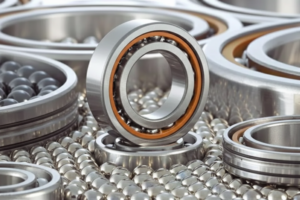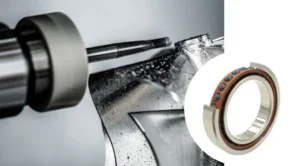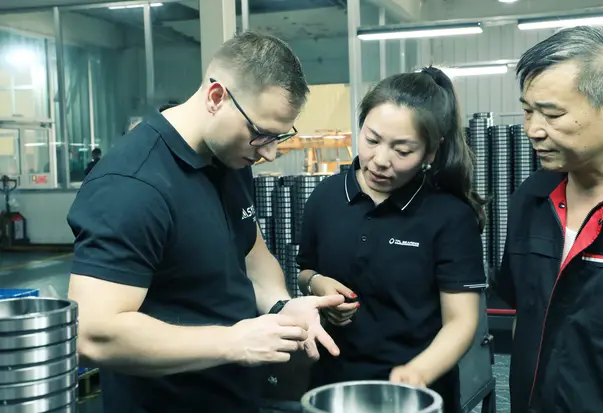Introduction
Have you noticed how tiny devices like smartwatches or drone cameras keep getting smaller yet more powerful? One secret lies in their “joints”: miniature flanged ball bearings.
But today, we’re focusing on their upgraded cousin—miniature flanged ball bearings with extended inner rings. What problems do they solve? Does your project need them?

Why Do We Need Better Miniature Bearings?
Traditional miniature bearings struggle in modern high-speed, high-precision applications:
- Misalignment issues: Short inner rings make installation error-prone.
- Limited durability: Frequent starts/stops or vibrations shorten lifespan.
- Poor adaptability: Non-standard shafts or housings require custom parts.
As industries like renewable energy, electric vehicles, and wearable tech boom, the demand is clear: “Make bearings smaller than a pea but tougher than a tank!” That’s where extended inner ring designs shine!
From Old School to Cutting-Edge: The Evolution of Bearing Design
The Flange Revolution (1980s–2000s)
Early miniature bearings worked like “cups without handles”—slippery and hard to align. The 1980s brought flanged designs:
- Self-alignment: Flanges act as “snap-fit guides” for perfect positioning.
- Axial security: Bearings stay put even during violent vibrations.
- Space-saving: No extra clamps needed—ideal for miniaturization.
By the 2000s, flanged bearings powered everything from computer cooling fans to DSLR camera lenses.

The Extended Inner Ring Era (2010s–Present)
Think of standard inner rings as “t-shirt sleeves” and extended ones as “long-sleeve jackets”:
- Extra grip: Longer contact with shafts reduces wobbling (30%+ precision gain).
- Multitasking: Replaces spacers or collars, cutting assembly steps by half.
- Custom-friendly: Extended sections can be tailored for odd-sized shafts.
The 2010s saw this design adopted in wind turbine pitch systems and Formula 1 gearboxes—where failure isn’t an option.

Inside a “Super Bearing”: Structure & Materials
Key Components Explained
- Extended inner ring → The “captain” gripping your shaft.
- Outer ring + flange → The “bodyguard” holding position.
- Ceramic/steel balls → “Ice skaters” reducing friction.
- Seals → “Invisible shields” against dust and grease leaks.
Standard vs. Extended Inner Rings: Quick Comparison
| Feature | Standard | Extended Inner Ring |
| Installation | Needs expert skills | Beginner-friendly |
| Vibration | Requires extra parts | Built-in stability |
| Customization | Limited options | Tailor-made lengths |
Material Matters
- Stainless steel: Perfect for wet environments (e.g., underwater sensors).
- Hybrid ceramics: 50% faster rotation (great for electric skateboard motors).
- Polymer coatings: Silent operation for noise-sensitive gadgets like hearing aids.
Real-World Performance: Where Do They Excel?
By the Numbers
- Speed: Up to 150,000 RPM (2x traditional bearings).
- Accuracy: ABEC-7 tolerance (±0.001 mm).
- Lifespan: 40% longer under the same load.
Surprising Applications
- Gaming Consoles: Haptic feedback motors in VR controllers.
- Agritech: Seed-planting drones needing weatherproof bearings.
- EV Batteries: Cooling fan bearings surviving 100°C+ heat.
How to Pick, Install & Maintain Them
3-Step Selection Guide
- Measure: Note shaft/housing sizes (include extended ring length!).
- Calculate loads: Radial-heavy? Pick wide flanges. Axial stress? Opt for double seals.
- Environment check: Saltwater exposure? Go stainless steel.
Installation Hacks
- Tools: Use nylon drivers—never hammer directly!
- Alignment: Laser alignment tools ensure <0.05 mm deviation.
- Flange bonus: Bolt holes on flanges simplify mounting.
Maintenance Tips
- Relubricate every 500 operating hours (use high-speed grease).
- Strange noises? Check for debris or worn balls.
- Store bearings flat in sealed bags to prevent rust.

The Future: Smaller, Smarter, Greener
Industry trends to watch:
- Self-lubricating bearings: 50% less maintenance for solar tracker systems.
- AI-powered wear sensors: Predict failures before they happen.
Conclusion: Precision Meets Innovation
Miniature flanged bearings with extended inner rings aren’t just components—they’re enablers of tomorrow’s tech. From whisper-quiet e-bike motors to earthquake-proof lab equipment, these tiny titans deliver big results.
If you also have some questions about bearings,
If you still have any questions about bearings, please feel free to contact TFL Bearings! Bearing experts will provide one-on-one answers to your bearing questions.
Meanwhile, TFL Bearings provides high-quality bearings to meet your different needs.




